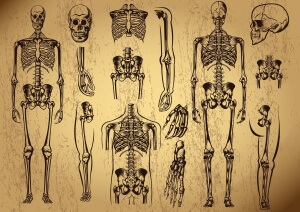
Last Saturday, Karen (the studio intern) and I took a field trip to a cadaver lab.
“Why?” is what most people ask me.
Because just like you, I was curious, intrigued with the idea of getting to view the body in a completely different way. I see, touch, move bodies every single day. And as I work, I’m thinking about the way the body moves, how it feels to move a certain way, what muscles are being worked…but I am coming from a perspective gained through books, drawings and slides. I wanted to get a closer look. I wanted a better perspective to view the body from.
The lab we went to isn’t something anyone can access. It was a treat we were even invited-I sit on Rotary and my organization donated money to their cause-thus special treatment.
The facility itself is an interesting concept. An attorney in LeRoy (if you’re a local its pronounced: ‘Lee-Roy’), Illinois by the name of Tom Pliura-also happens to be a physician. He felt as though there needed to be an opportunity for high school students to gain a more hands-on experience learning about the body. He organized area doctors, teachers and schools to have 33 advanced high-school students work in the dissection lab twice a week over spring semester. No credit is given-its completely volunteer (of both student and teacher). Here is a more in-depth article The Pantagraph put out in 2014.
Karen was excited to go. As a soon-to-be-graduate of the nursing program at IWU, shes eager to begin working with the patients-and while during her schooling, shes been able to work as a tech for OSF, there are not a lot of opportunities to watch surgeries or take a look inside the human body in this way.
I wasn’t really sure how I would respond. Sure, I was eager to see the joints and muscles-in theory. But how was I going to respond to a room with 3, mostly dissected bodies? I apparently turn a little red (according to Karen), but I think it was because it was cold in there.
We were informed upon going in that some students were working on genital dissection that day and because it was toward the end of the semester, the bodies were going to be heavily dissected at this point. The room was small-or at least, felt small-as there were approx 40 (living) people in the room. Walls were covered with anatomy posters. Students, teachers and visitors all wore lab coats and hovered around each of the three tables. I peeked at each body as we walked by, heading to the farthest table in the room. About 10 students and a teacher stood around the cadaver. They were all talking in a low tone and it felt as though most of the energy was directed at the upper part of the body. I noticed that this particular cadaver was male-as a female student was beginning to dissect a testicle. One of the students turned toward us and began ‘playing host’ (we’ll call him J). J started by showing us the heart and then a lung. All the terminology was anatomically correct and I immediately felt as though there was no way this guy could possibly be a high school student (even though his name tag gave away his school). He had poise, he was calm and not fumbling around with the organs he handled. He spoke with energy and was careful to make sure all the terms were correct (although, I’m sure many of us would not have noticed him getting anything wrong). I know we were all impressed.
Another student (we’ll call him M) waited ‘on deck’ to show us the brain they recently removed and separated into the two hemispheres, in addition, the pieces of the skull that were neatly cut. As a psych major, flashes of undergrad came back as he began to talk about the affect of Alzheimer’s on the brain and where the hypothalamus was.
From there J began to take us on a tour of arteries and nerves. The cadaver was lying supine-and because there were about 10 other people working at the other end, we were unable to flip the body over, but J was sure to take requests as to places on the body we were specifically interested in looking at. I got to see the patella and the knee joint, elbows-the wrist was particularly interesting.
Strangely enough, what I was most taken by was the energy of the room. The professionalism of the students and how they all seemed to be working toward the same goal: exploration. They were there because their need for information is strong and insatiable-just like so many of us. These are not lazy kids who blow off an opportunity, they take on the opportunity because the experience holds a higher value than credit or validation.
It just makes me think about opportunities we overlook or move on from because there isn’t some sort of reward. A posture we can’t land right away, a kind gesture to a stranger, maybe even just attending something new. This experience, I watched everyone being present in the moment. Time stood still.
Take a few moments to share: What experiences have you had in which the experience was the reward? What did that experience teach you?
Namaste,
~Carmen